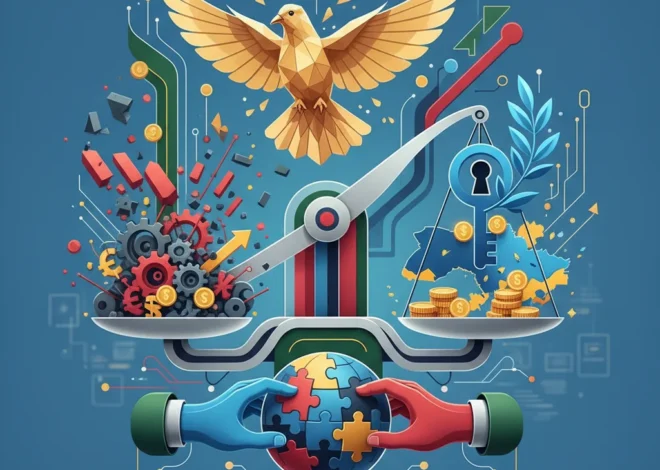
UK Inflation Cools to 3.6%: A Turning Point for the Economy, Your Investments, and the Future of Finance?
The economic landscape has been dominated by one persistent storm for the better part of two years: relentless, soaring inflation. It has eroded purchasing power, complicated business planning, and sent shockwaves through the global stock market. But now, a glimmer of light is breaking through the clouds. Recent data reveals that the UK’s inflation rate has fallen to 3.6% in the twelve months to October, a significant deceleration that signals a potential turning point in the nation’s battle against rising prices.
While this headline figure is a welcome sign of relief, it’s far from the end of the story. For investors, finance professionals, and business leaders, this number is not just a statistic; it’s a critical data point that will influence everything from monetary policy and investment strategies to the future trajectory of the UK economy. In this comprehensive analysis, we will dissect what this inflation cooldown truly means, explore the forces driving it, and map out the potential ripple effects across the worlds of finance, investing, and financial technology.
Deconstructing the Data: A Deeper Dive into the Numbers
The Consumer Prices Index (CPI) is the primary measure of inflation, tracking the average change in prices paid by consumers for a basket of goods and services. A drop from the punishing double-digit peaks seen earlier to 3.6% is the most substantial sign yet that the Bank of England’s aggressive monetary tightening is taking effect. However, to understand the full picture, we must look beyond the headline number and examine the trend and its components.
The journey to this point has been volatile. Let’s contextualize this recent figure by looking at the inflation trend over the past year.
Below is a simplified look at the UK’s CPI inflation rate over recent quarters, illustrating the downward trajectory from its peak.
| Time Period | Annual CPI Inflation Rate (Approx.) | Key Contributing Factors |
|---|---|---|
| Late 2022 | ~11% | Peak energy prices, post-pandemic supply chain issues, food price shocks |
| Q1 2023 | ~10% | Persistent food and services inflation, though energy pressures began to ease |
| Q2 2023 | ~8% | Significant “base effects” from energy prices, but core inflation remained sticky |
| Q3 2023 | ~6% | Slowing food price inflation, continued impact of higher interest rates |
| October (Latest) | 3.6% | Broad-based slowdown, particularly in energy and certain goods categories |
The key drivers of this recent fall are twofold. Firstly, energy prices have fallen significantly compared to the sky-high levels seen in the autumn of the previous year. This is a prime example of “base effects”—when a sharp price increase from the previous year is no longer included in the annual calculation, the new rate appears much lower. Secondly, there has been a noticeable slowdown in food price inflation, which has been a major source of pain for households. According to the Office for National Statistics (ONS), while prices are still rising, the rate of increase has decelerated, providing some much-needed respite for consumers.
The Economic Machinery at Work: Why Is Inflation Falling?
This cooldown is not accidental; it’s the result of a confluence of powerful economic forces, both domestic and global.
1. The Heavy Hand of Monetary Policy
The Bank of England has been at the forefront of the inflation fight, deploying its primary weapon: interest rate hikes. By raising the base rate repeatedly over the last 18 months, the central bank aimed to cool the economy by making borrowing more expensive for both consumers and businesses. This dampens demand, reduces spending, and, in theory, brings inflation back down to its 2% target. The 3.6% figure suggests this bitter medicine is finally working as intended, filtering through the complex systems of the UK’s banking and finance sectors.
2. Normalization of Global Supply Chains
The post-pandemic era was characterized by severe disruptions to global supply chains, leading to shortages and soaring shipping costs. These bottlenecks have largely cleared. The improved flow of goods has reduced cost pressures for manufacturers and retailers, a benefit that is now being passed on to consumers in the form of more stable prices.
3. Easing Commodity and Energy Markets
While geopolitical risks remain, global energy markets have stabilized considerably since the initial shock of the war in Ukraine. This global trend has been a major contributor to disinflation in the UK and other developed economies, directly impacting everything from petrol prices to household utility bills.
The Ripple Effect: What This Means for Your Financial World
A shift in the inflation narrative has profound implications for every corner of the financial ecosystem, from individual investors to the burgeoning fintech sector.
For Investors and the Stock Market
The reaction in the stock market is often nuanced. A falling inflation rate is generally seen as a positive for equities for several reasons:
- End of the Hiking Cycle: It signals that the central bank may be done raising interest rates. This reduces the appeal of cash and low-risk bonds, potentially pushing capital back into the stock market.
- Boost for Growth Stocks: Technology and other growth-oriented sectors, whose valuations are heavily dependent on future earnings, are particularly sensitive to interest rates. A stable or falling rate environment makes their future cash flows more valuable today.
- Improved Corporate Margins: Lower input costs (from commodities and energy) and more predictable pricing environments can help businesses improve their profitability.
For those involved in investing and trading, this may signal a time to reassess portfolio allocations. The defensive, value-oriented plays that outperformed during the high-inflation period might give way to renewed interest in growth and cyclical stocks. Similarly, the bond market breathes a sigh of relief, as the prospect of rate cuts in the medium-term future would lead to an appreciation in bond prices.
For the Fintech and Blockchain Space
The world of financial technology is also deeply connected to the macroeconomic climate. The high-inflation, high-rate environment of the past two years created a “VC winter,” where funding for fintech startups became scarce. A more stable economic outlook could thaw this freeze.
Furthermore, the inflation crisis spurred interest in alternative assets within the blockchain ecosystem, as some investors sought a hedge in cryptocurrencies. As inflation normalizes, the narrative around digital assets may shift from an “inflation hedge” to a focus on technological utility and innovation, such as decentralized finance (DeFi) and real-world asset tokenization. This changing environment will test the long-term value proposition of many fintech and blockchain projects beyond the speculative frenzy.
For the Broader Economy and Banking Sector
For the average person, this is a direct relief. While prices aren’t falling, the pace of their increase is slowing, helping household budgets stretch further. For the banking sector, it means a potential peak in mortgage rates, which could bring some stability back to the housing market. Savings rates, which rose sharply, may begin to plateau or decline as the Bank of England pivots its stance. This new chapter in economics is one of adjustment to a more “normal,” albeit fragile, state of affairs.
The Road Ahead: Navigating an Uncertain Future
The key question now is: what’s next? While the 3.6% figure is encouraging, the economic path forward is far from certain. Central banks, including the Bank of England, have emphasized their commitment to data-dependency. They will not be rushed into cutting rates until they are confident that inflation is sustainably returning to the 2% target.
Here’s a comparison of potential scenarios and their implications, as viewed by different economic schools of thought.
| Scenario | Description | Implication for Interest Rates | Market Impact |
|---|---|---|---|
| The Soft Landing (Optimistic) | Inflation continues to fall towards 2% without a significant economic downturn. Growth remains positive, and unemployment stays low. | Bank of England holds rates steady before beginning gradual cuts in mid-to-late 2024. | Highly positive for both stock market and bond investors. |
| Sticky Inflation (Pessimistic) | Inflation gets stuck between 3-4% due to persistent wage pressures. The “last mile” to 2% proves difficult. | Rates are held higher for longer, with the possibility of one final hike if data worsens. | Negative for growth stocks; favors value and cash. Bond market volatility would persist. |
| Hard Landing (Recession) | The cumulative effect of past rate hikes tips the economy into a recession. Unemployment rises, and demand collapses. | The Bank is forced to cut rates more quickly and aggressively than anticipated to stimulate growth. | Initially negative for stocks, but highly positive for government bonds as investors seek safety. |
Leading economists from institutions like the International Monetary Fund (IMF) and major investment banks are currently modelling these various outcomes, with a consensus slowly building around a “bumpy landing” that avoids the worst-case recessionary scenario but still involves a period of sluggish growth.
The Trillion-Dollar Blind Spot: Is the Private Credit Boom Hiding a Ratings Crisis?
Conclusion: A New Chapter in a Complex Story
The fall in UK inflation to 3.6% is more than just a data release; it’s a pivotal moment that marks the beginning of a new phase for the UK economy. It validates the painful but necessary actions taken by the Bank of England and offers a tangible sense of relief to households and businesses. For those engaged in finance, it necessitates a strategic recalibration, moving from a defensive posture to one that cautiously seeks opportunities in a changing landscape.
However, the journey is far from over. The global economy remains fragile, geopolitical risks persist, and the spectre of sticky core inflation looms. Navigating the months ahead will require a keen understanding of the interplay between monetary policy, market sentiment, and real-world economic data. This welcome news is a reason for optimism, but in the world of investing and economics, it is vigilance and adaptability that ultimately define success.


